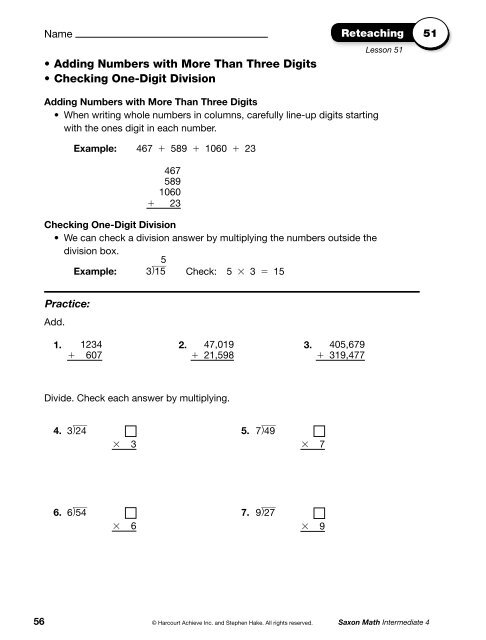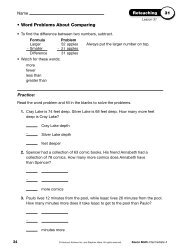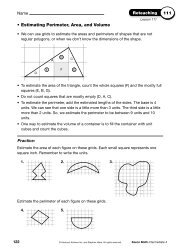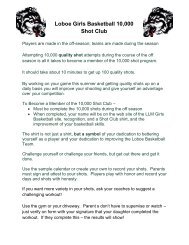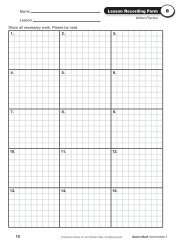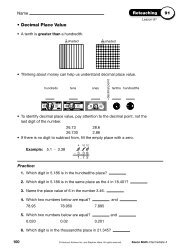Create successful ePaper yourself
Turn your PDF publications into a flip-book with our unique Google optimized e-Paper software.
Name• Adding Numbers with More Than Three Digits• Checking One-Digit Division<strong>Reteach</strong>ingLesson <strong>51</strong><strong>51</strong>Adding Numbers with More Than Three Digits• When writing whole numbers in columns, carefully line-up digits startingwith the ones digit in each number.Example: 467 + 589 + 10<strong>60</strong> + 2346758910<strong>60</strong>+ 23Checking One-Digit Division• We can check a division answer by multiplying the numbers outside thedivision box.___ 5Example: 3 ) 15 Check: 5 × 3 = 15Practice:Add.1. 12342. 47,0193.+ 0<strong>60</strong>7+ 21,598405,679+ 319,477Divide. Check each answer by multiplying.___4. 3 ) 24× 03___5. 7 ) 49× 07___6. 6 ) 54× 06___7. 9 ) 27× 0956 © Harcourt Achieve Inc. and Stephen Hake. All rights reserved. Saxon Math Intermediate 4
Name• Subtracting Numbers with More Than Three Digits• Word Problems About Equal Groups, Part 2<strong>Reteach</strong>ingLesson 5252Subtracting Numbers with More Than Three Digits• Always start subtracting in the ones column. Then continue subtracting fromright to left.Example: 1157 – 10801157– 108070 1<strong>51</strong>157– 1080770 1<strong>51</strong>157– 10800770 1<strong>51</strong>157– 10800077Word Problems About Equal Groups• In word problems, the word “each” usually means an equal-groups problem.• To find the number in each group, when given the total, we can divide by thenumber of groups._____________________number in each groupnumber of groups ) total in each grhhhhhoPractice:Subtract.1. 12342. 47,0193.– 0<strong>60</strong>7– 21,598405,679– 319,4774. There are 48 people. There are 6 equal teams. How many people are ineach team?______)people in each team5. Thirty-six students lined up equally on four risers for a chorus recital. How manystudents were on each riser?______)students on each riserSaxon Math Intermediate 4 © Harcourt Achieve Inc. and Stephen Hake. All rights reserved. 57
Name• One-Digit Division with a Remainder<strong>Reteach</strong>ingLesson 5353• Sometimes when we try to divide a number of things into equal groups we havesome things left over.Example: These 11 triangles cannot be divided into equal groups of four,because there are 3 triangles left over.11 triangles 2 groups of four triangles 3 triangles left over• We call the amount left over the remainder. Use the letter R to identify theremainder in an answer.___ 2 R34 ) 11– 83• Any remainder in a division problem must be smaller than the divisor.Practice:1. Circle groups of triangles below to show 18 ÷ 4. Write the answer shown byyour sketch.Divide. Write each answer with a remainder.R___ R2. 2 ) 15___ R3. 5 ) 13___ R4. 4 ) 21___ R5. 17 ÷ 2 ) 17___ R6. 27 ÷ 6 ) 27___ R7. 20 ÷ 3 ) 2058 © Harcourt Achieve Inc. and Stephen Hake. All rights reserved. Saxon Math Intermediate 4
Name• The Calendar• Rounding Numbers to the Nearest Thousand<strong>Reteach</strong>ingLesson 5454The Calendar• A common year has 365 days.• A leap year has 366 days. The extra day is added to February. A leap yearhappens every 4 years.• This will help you remember how many days are in each month:Thirty days have September, April, June, and November.The other months have 31 days, except February,which has 28, or 29 if it is leap year.• A decade is ten years. A century is one hundred years.• To find the amount of time between two years, subtract.1996– 198313 yearsRounding Numbers to the Nearest Thousand• To round a number to the nearest thousand:1. Look at the hundreds place.2. Ask: Is the digit in the hundreds place 5 or more? (5, 6, 7, 8, 9)Yes Add 1 to the thousands place.No The thousands place stays the same.4. Replace the numbers after the thousands place with zeros.Practice:Example: 6 2 59 <strong>60</strong>00Remember to write the units.1. How often does a leap year occur?2. According to this calendar, what is the date of the third Wednesdayof the month?3. How many years were there from 1913 to 1958?Round to the nearest thousand.4. 7901 5. 3399MAY 2014S M T W T F S1 2 34 5 6 7 8 9 1011 12 13 14 15 16 1718 19 20 21 22 23 2425 26 27 28 29 30 31Saxon Math Intermediate 4 © Harcourt Achieve Inc. and Stephen Hake. All rights reserved. 59
Name• Prime and Composite Numbers<strong>Reteach</strong>ingLesson 5555• Multiples are the numbers we say if we count by a number. For example, themultiples of 4 are: 4, 8, 12, 16, 20, 24, ...• You can find multiples in a multiplication table.• To find the factors of a whole number:1. Start with the number 1.2. End with the number given.3. Find all the numbers that divide evenly into the given number:Will 2 divide evenly?Will 3 divide evenly? (and so on)4. Make sure the factors are listed in order.Example: List the factors of 30. 1 , 2 , 3 , 5 , 6 , 10 , 15 , 30• Counting numbers that have exactly two different factors are prime numbers.• A number with more than two factors is a composite number.• The number 1 has one factor and is not prime or composite.Practice:1. Write all the prime numbers less than 12.2. What is the eighth multiple of 3?3. Is the last digit of the multiples of 4 odd or even?4. List the six factors of 12.5. List the factors of 16., , , ,6. Two factors of 20 are 1 and 20. Find four more factors of 20., , ,7. List the factors of 11. ,8. List the factors of 24. , , , ,, ,<strong>60</strong> © Harcourt Achieve Inc. and Stephen Hake. All rights reserved. Saxon Math Intermediate 4
Name• Using Models and Pictures to Compare Fractions<strong>Reteach</strong>ingLesson 5656• When we draw pictures to compare fractions, the pictures must have the sameshape and equal size. These are called congruent figures.• Another way to compare fractions:1. Cross multiply.2. Compare the products.8 3231428 3, so 314Practice:Compare the fractions and shade the rectangles to illustrate each comparison. Usefraction manipulatives for help.3523142<strong>51</strong>.2.3<strong>51</strong>357453.4.382749585.6.Saxon Math Intermediate 4 © Harcourt Achieve Inc. and Stephen Hake. All rights reserved. 61
Name• Rate Word Problems<strong>Reteach</strong>ingLesson 5757Example: If a cyclist rides 15 miles per hour, how far will he ride in 6 hours?Practice:1. Name the two things the problem is about:mileshours2. Fill in what you know and what you are looking for: ______ miles ___ 15hour 1 = __ ? 63. Draw a loop around the numbers that are diagonally opposite.The loop should never include the question mark.miles___ 1<strong>51</strong> = __ ?hour64. Multiply the numbers inside the loop and divide by the number outsidethe loop if it is not 1: 6 × 15 = 90 miles1. Maya drove 65 miles in one hour. At that rate, how far can she drivein 7 hours?Multiply the loop.miles___ 6<strong>51</strong> = __ ?hours miles2. Kirby could type 42 words in 3 minutes. At that rate, how many words could hetype in 30 minutes?Multiply the loop.words___ 423 = __ ?minutes words3. Emma is the fastest runner in her class. She can run 2 miles in 15 minutes.At that rate, how many minutes would it take her to run a 6-mile race?Multiply the loop.miles___ 2minutes 15 = __?minutes62 © Harcourt Achieve Inc. and Stephen Hake. All rights reserved. Saxon Math Intermediate 4
Name• Multiplying Three-Digit Numbers<strong>Reteach</strong>ingLesson 5858• We can multiply three-digit numbers the same way we multiplied two-digitnumbers: one digit at a time.Example 1:Multiply the ones digit. Multiply the tens digit. Multiply the hundreds digit.234× 28• Try to use mental math to carry tens.Example 2:23 4× 268234× 2468Multiply the ones digit. Multiply the tens digit. Multiply the hundreds digit.Carry the 4. Add the 4.4509× 55450 9× 5454509× 52545Practice:Multiply. Remember to write the dollar sign in money problems.1. 2482. $6183.× 004× 005$3.87× 00.74. 5015. $1176.× 006× 009$8.34× 0.037. $4.398. 7239.× 0.07× 008916× 004Saxon Math Intermediate 4 © Harcourt Achieve Inc. and Stephen Hake. All rights reserved. 63
Name• Estimating Arithmetic Answers<strong>Reteach</strong>ingLesson 5959• To estimate an answer we often round numbers first.• When we estimate, we find an answer that is “close to” the exact number.• Estimating can help you see whether your exact answers make sense.486+ 319500+ 30080064× 04<strong>60</strong>× 0424053 ÷ 5___ 105 ) 50Practice:1. Estimate Exact 2. Estimate Exact 3. Estimate Exact6168+ 476168+ 47<strong>51</strong>9+ 354<strong>51</strong>9+ 354473– 250473– 2504. Estimate Exact 5. Estimate Exact 6. Estimate Exact72– 6772– 6739× 0739× 07465× 008465× 0087. Estimate Exact 8. Estimate Exact___)______4 ) 63 )___6 ) 559. Carlos estimated the product of 6 and 6384 by multiplying 6 by <strong>60</strong>00. WasCarlos’ estimate more than, equal to, or less than the actual product? Why?Carlos’ estimate washe rounded 6384 down tothe actual product becausebefore multiplying.64 © Harcourt Achieve Inc. and Stephen Hake. All rights reserved. Saxon Math Intermediate 4
Name• Rate Problems with a Given Total<strong>Reteach</strong>ingLesson <strong>60</strong><strong>60</strong>• Rate problems are equal-group problems. To find a missing number in an equalgroupsproblem (when the total is given), we can divide.Example: Marquez can read 4 pages in 1 minute. How long will it take him toread 32 pages?________________missing numberknown number ) totalxxxxxxvxxx_________ 8 minutes4 pages ) 32 pages8 minutes to read 32 pagesPractice:1. Samantha can sign 15 thank-you cards in 1 minute. How long will it takeSamantha to sign cards for the 45 people in her dance troop?______)minutes2. Farley went skiing with his family. If he travels at 6 feet per second, how long willit take him to travel 48 feet?______)seconds3. Destiny makes $7 an hour working at the animal shelter. If her paycheck at theend of the day is $42, how many hours did she work?______)hoursSaxon Math Intermediate 4 © Harcourt Achieve Inc. and Stephen Hake. All rights reserved. 65
Name• Displaying Data Using Graphs<strong>Reteach</strong>ingInvestigation 6Inv. 6• A survey is an effort to gather specific information about a group, or a population.• A pictograph uses pictures to display information.• A bar graph displays numerical information with shaded rectangles or bars.• A line graph displays numerical information as points connected by line segments.Line graphs are often used to show information that changes over time.• Circle graphs or pie graphs are often used to display information about parts of awhole.• A legend is often shown on a graph to describe the meaning of symbols.Example:Type of Dogs at the Dog Park1Poodle6Terriers2GermanShepherds3MixedBreedsPractice:Use the circle graph in the example to answer problems 1–3.1. How many German Shepherds and Poodles are at the Dog Park?2. What is the total number of dogs represented by the circle graph?3. Which type of dog does the largest slice of the graph represent?4. Create a bar graph to represent the same information as the circle graph.5. Is it easier to read the results from the bar graph or the circle graph?Explain why.66 © Harcourt Achieve Inc. and Stephen Hake. All rights reserved. Saxon Math Intermediate 4


